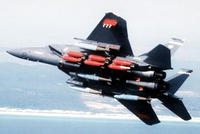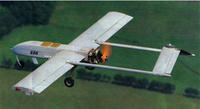-
USAF develops UAVs that fly themselves
A U.S. Air Force project will allow UAVs to fly themselves — in multiple-aircraft formations — without colliding; the USAF is working to develop systems that unmanned aircraft can use to sense the presence of other aircraft and take action to prevent collisions that are safe enough so that UAVs can perform any Air Force mission
-
-
Giant blimps to ferry hospitals, buildings to disaster zones

Giant airship will be able to lift up to 150 tons — more than seven times the weight that helicopters are able to carry; the airship, which will be able to move aid — or even portable hospitals and entire buildings — to remote areas or disaster zones, harnesses aerostatic lift, meaning it is able to fly using lighter-than-air (LTA) gases that keep it buoyant rather than aerodynamic lift
-
-
Special forces interest in Panther tiltrotor UAV family
Special forces officers from several potential clients were in Israel this week to see a demonstration of new UAV which combines the capabilities of an aircraft and a helicopter; the Panther uses an automatic flight control system to manage the transition between its hovering take-off phase to forward flight and back before landing
-
-
Portable 3d map-maker developed
UC Berkeley researchers develop a backpack system containing cameras, lasers, and inertial sensors which can be carried around indoors and generate a detailed, accurate 3D map of the spaces it moves through
-
-
Around-the-world blimp race scheduled for 2011
A Texan businessman is organizing a year-long around-the-world race for airships — he says he is on track to start the inaugural event next year; the race is intended to be run as seventeen back-to-back legs that would see the competing ships set off from the zero meridian in London before progressing around the world in an easterly direction
-
-
U.S. to make Internet wiretaps easier

The Obama administration plans to submit a bill next year that would require all online services that enable communications to be technically equipped to comply with a wiretap order; this would include providers of encrypted e-mail, such as BlackBerry, networking sites like Facebook, and direct communication services like Skype; federal law enforcement and national security officials say new the regulations are needed because terrorists and criminals are increasingly giving up their phones to communicate online
-
-
New UAV to loiter the sky for five years without landing
Boeing has been given $89 million to build Vulture — a large solar-powered UAV intended to cruise the stratosphere for five years without landing; the idea is to achieve a platform which combines the good qualities of both satellites and aircraft with none of the downsides of either
-
-
New report: UAVs for Border Security -- market & technologies outlook 2010-15
The use of UAVs in border security missions around the world is expanding rapidly from very little activity today; this expansion will create new markets and new business opportunities, particularly for integrated capabilities guided by an operating concept and turn-key packages that include equipment, training, operations, and maintenance
-
-
U.S.: Mexico's drug war posing growing threat to U.S. national security
The Obama administration sees the drug-related violence sweeping Mexico as a growing threat to U.S. national security and has launched a broad review of steps the military and intelligence community could take to help combat what U.S. officials describe as a “narcoinsurgency”; one problem with increased intelligence collaboration: U.S. agencies have been wary of sharing some intelligence because of concerns that some of their Mexican counterparts may be on the payroll of the cartels
-
-
Crash of UAV copter with foliage-penetrating radar sheds light on secret program
Two emerging security challenges to the United States — the growing violence of the drug war south of the border, and growing concerns about climate change-driven conflicts in Africa and Asia — have led DARPA to fund the development of technology that will allow U.S. special forces to see through the dense canopy of a jungle; the recent crash, during trials, in the jungle of Belize of a Boeing A160T equipped with foliage-penetrating radar sheds some light on this programs; spokesman of the U.S. Special Operations Command (SOCOM) said more than 90 percent of the objectives of the Belize trials had been met when the crash terminated the effort
-
-
U.S. military conflicted over domestic use of drones
The 2 August incident, in which a U.S. Navy UAV lost communication with its operators and wondered dangerously close to restricted air space over Washington, D.C., revives debate over domestic use of UAVs; head of U.S. Northern Command and NORAD believes drones are “where the future is going,” but says the military needs drones that can be trusted not to wander off
-
-
Fake chips from China threaten U.S. military systems

To withstand the rigors of battle, the Defense Department requires the chips it uses to have special features, such as the ability to operate at below freezing temperatures in high-flying planes; because it pays extra for such chips, experts say, the Defense Department has become a prime target for counterfeiters, most of them Chinese companies; from November 2007 through May 2010, U.S. Customs officials said they seized 5.6 million bogus chips — yet many more are finding their way into the United States and even the military
-
-
The laser designator-equipped Shadow UAV offers smart bombs more precision

The light weight laser designators enable the UAV to designate targets for laser guided smart bombs when more accuracy than GPS guided weapons is needed: GPS guided weapons hit within a 10 meter/31 foot circle, while laser guidance is good for 1-2 meters, or 3-6 feet
-
-
Local anger mounts over counter-terrorism-funded CCTVs
There are 4,200,000 CCTVs installed in the United Kingdom, leading many to describe the kingdom as a “surveillance society”; 218 of these CCTVs caused a firestorm: they were installed in a predominantly Muslim section of Birmingham — along with 169 automatic license plate recognition (ANPR) cameras; the reason for local anger: the funding for the deployment came from the U.K.’s counter-terrorism, rather than crime-fighting, authorities; residents argue this makes them all look like potential terrorists
-
-
IDF shows Hezbollah removing arms from exploded home
One lesson both Hezbollah and Hamas have drawn from their recent military encounters with Israel — Hezbollah in July-August 2006, Hamas in December 2008-January 2009 — is that both would benefit from increasing even more the use of the Shi’a population in southern Lebanon (Hezbollah) and the Palestinian population in the Gaza Strip (Hamas) as human shields against the Israeli military; hiding weapons and explosives in residential buildings, however, increases the number of deadly accident, as the one which occurred in Lebanese village of Shehabiyeh last Friday
-
- All
- Regional
- Water
- Biometrics
- Borders/Immig
- Business
- Cybersecurity
- Detection
- Disasters
- Government
- Infrastructure
- International
- Public health
- Public Safety
- Communication interoperabillity
- Emergency services
- Emergency medical services
- Fire
- First response
- IEDs
- Law Enforcement
- Law Enforcement Technology
- Military technology
- Nonlethal weapons
- Nuclear weapons
- Personal protection equipment
- Police
- Notification /alert systems
- Situational awareness
- Weapons systems
- Sci-Tech
- Sector Reports
- Surveillance
- Transportation
Advertising & Marketing: advertise@newswirepubs.com
Editorial: editor@newswirepubs.com
General: info@newswirepubs.com
2010-2011 © News Wire Publications, LLC News Wire Publications, LLC
220 Old Country Road | Suite 200 | Mineola | New York | 11501
Permissions and Policies
Editorial: editor@newswirepubs.com
General: info@newswirepubs.com
2010-2011 © News Wire Publications, LLC News Wire Publications, LLC
220 Old Country Road | Suite 200 | Mineola | New York | 11501
Permissions and Policies
